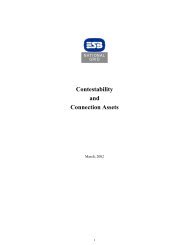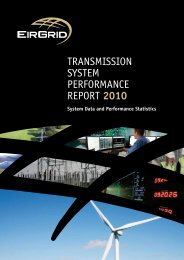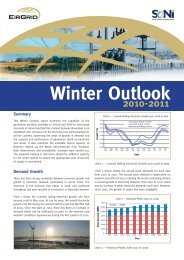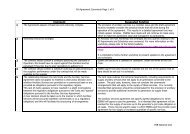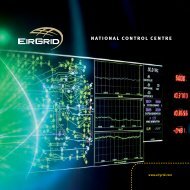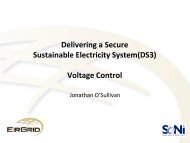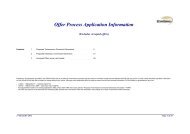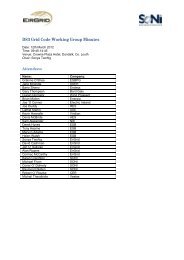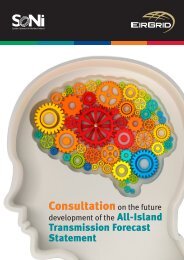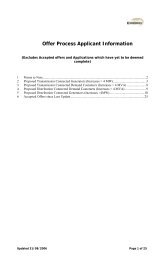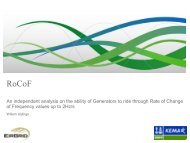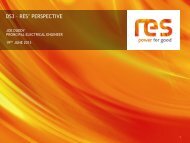EWIC_IEI Presentation 29.04.10.ppt [Compatibility Mode] - Eirgrid
EWIC_IEI Presentation 29.04.10.ppt [Compatibility Mode] - Eirgrid
EWIC_IEI Presentation 29.04.10.ppt [Compatibility Mode] - Eirgrid
You also want an ePaper? Increase the reach of your titles
YUMPU automatically turns print PDFs into web optimized ePapers that Google loves.
Benefits of Interconnection<br />
•Security Of Supply<br />
•Promote Competition in The Electricity<br />
Sector<br />
•Accommodate Growth Of Renewable<br />
Energy<br />
•Reduce Dependence on Imported Fuels<br />
•Downward Pressure on Price<br />
•Achievement of National and European<br />
Objectives
East West Interconnector Background<br />
• Key Strategic Project<br />
• Priority Interconnector Project - DG TREN January<br />
2007<br />
• ‘..Critical National Strategic Importance..’ – NDP<br />
2007-2013<br />
• CER to arrange for design of competition for construction of<br />
a 500MW interconnector at earliest possible date (2012 or<br />
earlier)<br />
• Upon completion, I/C to be owned by EirGrid<br />
• Work on selection of sub sea route and sites and<br />
associated grid reinforcement to proceed in parallel with<br />
selection of developer process
Project Risk Register and Program<br />
• Top 3 Generic Risks to a large energy infrastructure project<br />
1. Planning<br />
2. Infrastructure Access<br />
3. Procurement – lead times<br />
• Pick a route and begin route surveys?<br />
• Planning will take time?<br />
• 2-3years to build a HVDC scheme once we press the go button and<br />
design and route is finalised?<br />
• >2 year lead time for cable slots with manufacturers?<br />
• Procurement including competition design, specification ,evaluation and<br />
contract negotiations under the negotiated procedure of a complex<br />
scheme takes 2 years?
Project Scoping<br />
• Concept to Reality<br />
• Need a well defined route to get comparative offerings and value<br />
• Need Planning to secure Finance<br />
• Need Grid Access to deliver benefits<br />
• Competition in the HVDC market is limited with long lead times<br />
for equipment<br />
• Turnkey versus multi-contract<br />
• Newer Technology versus more established Technology<br />
• Lots approach to cables and converter stations<br />
• Can it be done for 2012? Yes, if we parallel*<br />
‣ Route development /selection with procurement<br />
‣ Planning with contract negotiations and design<br />
* subject to planning and procurement
Parallel Processes<br />
2007 08 09 10 11 12<br />
Route<br />
Dev<br />
BCAP<br />
26 months<br />
30 months<br />
Procurement Design Construction<br />
Project<br />
Scoping<br />
Contract<br />
Award<br />
Financial<br />
close
•Connects To Irish Grid At Woodland 400kv Substation<br />
The Route<br />
•Irish Land Cable Route –Approx 45km<br />
•Connects To UK Grid At Deeside 400kv<br />
Substation<br />
•Welsh Land Cable Route – Approx 30km
Irish Land Route
Welsh Land Route
Marine Routing<br />
•Irish Landfall At Rush Beach, North Co. Dublin<br />
•186km Marine Cable Route<br />
•Welsh Landfall At Barkby Beach, North Wales
Marine Route
Marine Survey
Recent Milestones<br />
•Government Approval / Contract Award March 2009<br />
•Planning Permission in Britain Sep 2009<br />
•Planning Approval Granted in Ireland Sep 2009<br />
•European Investment Bank funding secured Sep 2009<br />
•Granted Foreshore Licence in Britain Oct 2009<br />
•Commencement of Works in Wales Nov 2009<br />
•EU Grant secured March 2010<br />
•Full Notice to Proceed March 2010
North Ocean 102 Cable Laying Vessel<br />
ABB HVC Karlskrona
Road works in Wales
Facts & Figures<br />
•500MW Continuous Rated Power<br />
•Overload Capacity Up To 550MW<br />
•DC Cable Voltage ±200kV<br />
•Reactive Power Capability<br />
•Total Estimated Losses At Rated Power<br />
–30MW<br />
•Completion Date Q3 2012
<strong>EWIC</strong> – Technical <strong>Presentation</strong><br />
• LCC and VSC Converters<br />
• ABB VSC Projects<br />
• VSC Main Circuit Plant<br />
• <strong>EWIC</strong> Converter Station Layout<br />
• <strong>EWIC</strong> Bridge Operation<br />
• <strong>EWIC</strong> Control Interface<br />
• Questions
ABB HVDC Light© - Features<br />
• Inherent Capability To Operate In A Weak Or Dead AC Network<br />
– Has Black Start Capability<br />
– Block load pick-up, frequency droop (VSC is the swing bus)<br />
• Can Control Active and Reactive Power Flows Fast and Independently<br />
• Can Be Operated As Static VAr Compensators<br />
• Less Shunt Capacitance Required For Filtering<br />
• Very Reliable With Redundancy Provided For All Parts<br />
• Will Be Operated Remotely From National Control Centre (NCC) In Dublin
Other HVDC Light© Interconnectors<br />
• ABB has Significant Operational Experience with HVDC Light<br />
Project Country In Service<br />
(Year)<br />
Power<br />
(MW)<br />
DC<br />
Voltage<br />
(kV)<br />
Distance<br />
(km)<br />
Connection<br />
HÄLLSJÖN Sweden 1997 3 +/- 10 10 Over head<br />
GOTLAND Sweden 1999 50 +/- 80 70 Cable<br />
DIRECTLINK Australia 2000 180 (3 x 60) +/- 80 65 Cable<br />
TJÆREBORG Denmark 2000 7.2 +/- 9 4.4 Cable<br />
EAGLE PASS USA 2000 36 +/- 15.9 0 Back to Back<br />
CROSS SOUND USA 2002 330 +/- 150 40 Cable<br />
MURRAYLINK Australia 2002 220 +/- 150 180 Cable<br />
TROLL A Norway 2005 82 (2 x 41) +/- 60 67 Cable<br />
ESTLINK Estonia to Finland 2006 350 +/- 150 105 Cable<br />
VALHALL Norway 2010 78 150 292 Cable<br />
NORD E.ON 1 Germany 2009 400 +/- 150 203 Cable<br />
CAPRIVI LINK Namibia 2010 300 350 970 Over head<br />
<strong>EWIC</strong> Ireland to UK 2012 500 +/- 200 260 Cable
HVDC - LCC “Classic” and VSC “Light ©”<br />
Capability LCC VSC<br />
Bulk Power Transmission Up to 3000 Up to 500 MW (present)<br />
MW<br />
Black start No Yes<br />
Weak networks No Yes<br />
Dynamic reactive control No Yes<br />
Reactive damping No Yes<br />
Power reversal (time) Limited Fast<br />
Dynamic power control (including run-back) Yes Yes<br />
Real-power damping Yes Yes<br />
Frequency response Yes Yes<br />
Harmonic filters required Yes Yes (less)<br />
Losses Yes (less) Yes
ABB HVDC Light© - Converter Components<br />
– Bridge<br />
• IGBT with anti-parallel diode<br />
• Optical triggered IGBT’s<br />
• 2, 3 and Multi Level Bridges<br />
– Phase Reactor<br />
• Energy Storage, LP Filter<br />
– Filters<br />
• Shunt higher harmonics<br />
– Transformer<br />
• Match system voltage to filter bus voltage<br />
• Extend reactive power range with tap-changer<br />
• <strong>EWIC</strong>: 400kV/260kV
Voltage Source Converter Technology<br />
• LCC Utilise Thyristors<br />
• VSC Utilise Solid State Devices – IGBTs<br />
(Insulated Gate Bipolar Transistors)<br />
• Low Voltage Drop<br />
• Rated For High Currents<br />
• Robust under short circuits<br />
• Not reliant on line or external circuit to<br />
force commutation<br />
• Means VSC can be used to supply dead<br />
or weak networks<br />
• Can Achieve Full Power Reversal Almost<br />
Instantly
ABB HVDC Light© - Examples of Cables<br />
DC sea cable DC land cable AC 400kV cable
ABB HVDC Light© - <strong>EWIC</strong> General Layout<br />
+/- 200kV DC Cables<br />
Control<br />
Bld.<br />
DC Hall<br />
Valves<br />
Reactors<br />
Filters<br />
Transformers<br />
Storage<br />
Filters<br />
400kV AC Cables
VSC Converter Technology<br />
• Voltage Source Converter:<br />
• Diagram shows a 2-level Pulse Width<br />
Modulation (PWM) bridge<br />
• Fundamental frequency formed by<br />
filtering high frequency PWM voltage<br />
• With PWM, it is possible to control both<br />
active & reactive power independently<br />
VSC three phase converter<br />
• With OPWM, reduce losses, eliminate<br />
low-order harmonics<br />
The PWM pattern and the corresponding<br />
power frequency voltage of a VSC<br />
converter
VSC – Voltage Representation<br />
Vector representation:<br />
b<br />
β<br />
• Relates switch positions to phase<br />
potentials<br />
++-<br />
-+-<br />
• Relates phase potentials to zerosequence<br />
free phase voltage<br />
-++<br />
+--<br />
α<br />
a<br />
• Relates DC side current and voltage to<br />
AC side phase voltages<br />
• For 3-phase 2-level bridge 8 realisable<br />
switch positions, 6 used for generating<br />
phase voltages<br />
c<br />
--+<br />
+-+
VSC - PWM Switching Sequences 1<br />
+Udc<br />
a<br />
b<br />
c<br />
+<br />
-<br />
-<br />
HP<br />
-Udc<br />
a<br />
+Udc<br />
-Udc<br />
b<br />
++-<br />
-+-<br />
β<br />
b<br />
+Udc<br />
-Udc<br />
-++<br />
+--<br />
α<br />
a<br />
c<br />
+Udc<br />
-Udc<br />
c<br />
--+<br />
+-+
VSC - PWM Switching Sequences 2<br />
+Udc<br />
a<br />
b<br />
c<br />
+<br />
+<br />
-<br />
HP<br />
-Udc<br />
a<br />
+Udc<br />
-Udc<br />
b<br />
++-<br />
-+-<br />
β<br />
b<br />
+Udc<br />
-Udc<br />
-++<br />
+--<br />
α<br />
a<br />
c<br />
+Udc<br />
-Udc<br />
c<br />
--+<br />
+-+
VSC - PWM Switching Sequences 3<br />
+Udc<br />
a<br />
b<br />
c<br />
-<br />
+<br />
-<br />
HP<br />
-Udc<br />
a<br />
+Udc<br />
-Udc<br />
b<br />
++-<br />
-+-<br />
β<br />
b<br />
+Udc<br />
-Udc<br />
-++<br />
+--<br />
α<br />
a<br />
c<br />
+Udc<br />
-Udc<br />
c<br />
--+<br />
+-+
VSC - PWM Switching Sequences 4<br />
+Udc<br />
a<br />
b<br />
c<br />
-<br />
+<br />
+<br />
HP<br />
-Udc<br />
a<br />
+Udc<br />
-Udc<br />
b<br />
++-<br />
-+-<br />
β<br />
b<br />
+Udc<br />
-Udc<br />
-++<br />
+--<br />
α<br />
a<br />
c<br />
+Udc<br />
-Udc<br />
c<br />
--+<br />
+-+
VSC - PWM Switching Sequences 5<br />
+Udc<br />
a<br />
b<br />
c<br />
-<br />
-<br />
+<br />
HP<br />
-Udc<br />
a<br />
+Udc<br />
-Udc<br />
b<br />
++-<br />
-+-<br />
β<br />
b<br />
+Udc<br />
-Udc<br />
-++<br />
+--<br />
α<br />
a<br />
c<br />
+Udc<br />
-Udc<br />
c<br />
--+<br />
+-+
VSC - PWM Switching Sequences 6<br />
+Udc<br />
a<br />
b<br />
c<br />
+<br />
-<br />
+<br />
HP<br />
-Udc<br />
a<br />
+Udc<br />
-Udc<br />
b<br />
++-<br />
-+-<br />
β<br />
b<br />
+Udc<br />
-Udc<br />
-++<br />
+--<br />
α<br />
a<br />
c<br />
+Udc<br />
-Udc<br />
c<br />
--+<br />
+-+
VSC - PWM Switching Sequences<br />
+Udc<br />
a<br />
b<br />
c<br />
+<br />
-<br />
-<br />
HP<br />
-Udc<br />
a<br />
+Udc<br />
-Udc<br />
b<br />
++-<br />
-+-<br />
β<br />
b<br />
+Udc<br />
-Udc<br />
-++<br />
+--<br />
α<br />
a<br />
c<br />
+Udc<br />
-Udc<br />
c<br />
--+<br />
+-+
VSC – Harmonics<br />
b<br />
β<br />
Square Wave Modulation:<br />
++-<br />
-+-<br />
Phase Potential (referred to DC midpoint)<br />
+Udc<br />
-++<br />
+--<br />
α<br />
a<br />
-Udc<br />
Phase Voltage (filter bus)<br />
ωt<br />
+4/3Udc<br />
c<br />
--+<br />
+-+<br />
-4/3Udc<br />
ωt<br />
By Fourier analysis:<br />
Positive Sequence<br />
Negative Sequence<br />
Zero sequence<br />
1, 7, 13, 19, 25, 31, 37…………<br />
5, 11, 17, 23, 29, 35…………….<br />
3, 9, 15, 21, 27, 33………………
VSC - Harmonic Elimination with OPWM<br />
Increasing Switching Frequency:<br />
+Udc<br />
-Udc<br />
ωt<br />
a1<br />
a2a3<br />
No. switch angles = A<br />
By increasing switching frequency:<br />
• Increase degrees of freedom for<br />
harmonic elimination<br />
• ¼ wavelength symmetric switching<br />
• Eg. for 2-Level Bridge:<br />
• A= 5 (eliminate up to 4 harmonics)<br />
• Reduce need for filters, size of filters
VSC – Simplified Control Scheme<br />
Uac<br />
+/-Udc<br />
Q Ref<br />
-<br />
Σ<br />
Phase<br />
Ref<br />
PLL<br />
OPWM<br />
-<br />
Σ<br />
Udc Ref<br />
Q<br />
Control<br />
Udc<br />
Control
Converter – PQ Diagram (rated output)<br />
Real Power (MW)<br />
(500, -165) (500, 165)<br />
+P, - Q<br />
+P, +Q<br />
INVERTER OPERATION<br />
(Feeding into AC network)<br />
Reactive Power<br />
(MVAr )<br />
RECTIFIER OPERATION<br />
Drawing power from AC network<br />
-P, -Q<br />
-P, +Q<br />
(530, -175)<br />
(530, 175)
ABB HVDC Light© - Typical Operator Interface
End of <strong>Presentation</strong><br />
•Questions?<br />
• Further info:<br />
• EirGrid website: www.eirgrid.com<br />
• Project website: www.interconnector.ie<br />
• Planning websit www.eirgrideastwestinterconnector.ie<br />
• ABB HVDC: www.abb.com/hvdc


![EWIC_IEI Presentation 29.04.10.ppt [Compatibility Mode] - Eirgrid](https://img.yumpu.com/27866204/1/500x640/ewic-iei-presentation-290410ppt-compatibility-mode-eirgrid.jpg)
